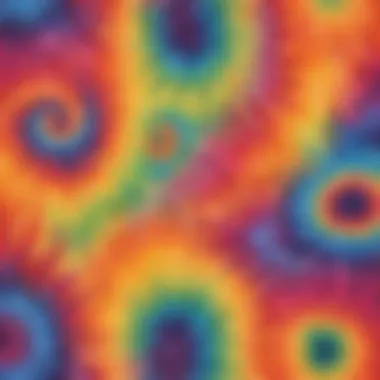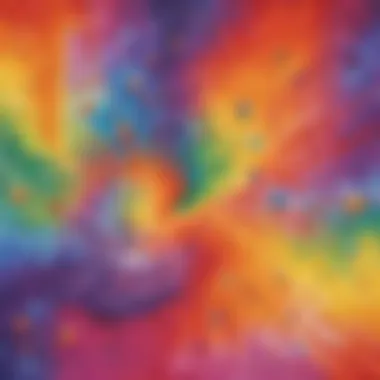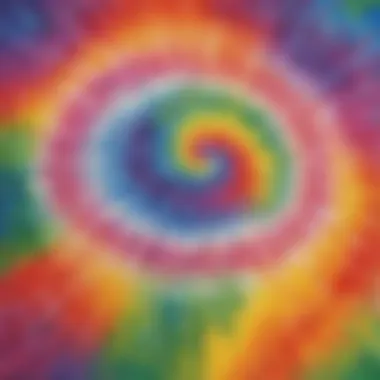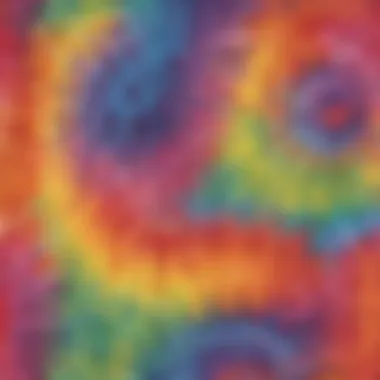Unveiling Secrets of Fiber Reactive Tie Dye Techniques for Young Science Enthusiasts


Science Fun Facts
Tie dye is an ancient art form that dates back to as early as the 6th century. Did you know that the vibrant colors in tie dye designs are created by using fiber reactive dyes that chemically bond with the fabric?
Discover the Wonders of Science
When it comes to tie dye, understanding the science behind fiber reactive dyes is crucial. These dyes contain groups that react with the fabric molecules, forming a permanent bond that resists fading or washing out.
Science Experiment Showcase
Ready to dive into the colorful world of tie dye? Explore different techniques such as accordion folds, spiral patterns, and crumple designs. Remember to use 100% cotton fabric for the best dye absorption!
- Materials List: 100% cotton t-shirts, fiber reactive dyes, squeeze bottles, rubber bands, gloves, plastic wrap.
- Step-by-Step Instructions: Start by pre-washing the fabric to remove any sizing. Prepare the dye solutions following the manufacturer's instructions. Use rubber bands to create patterns on the fabric before applying the dye.
- Safety Tips and Precautions: Always wear gloves when working with dyes to prevent skin irritation. Work in a well-ventilated area and cover surfaces to avoid staining.
Make Your Own Masterpiece
Tie dye is a wonderful way to unleash your creativity and create vibrant, personalized pieces of art. Experiment with different color combinations, layering techniques, and fabric manipulation to design unique patterns that reflect your style and personality.
Bringing Science and Art Together
By exploring fiber reactive tie dye techniques, young Science enthusiasts can not only express their artistic side but also gain a deeper understanding of chemistry and color theory. Each dyeing session becomes a fun and educational experience, blending art and science seamlessly.
Conclusion
With its rich history and endless creative possibilities, fiber reactive tie dye is a captivating art form that offers a blend of science, art, and self-expression. So grab your supplies, unleash your imagination, and embark on a colorful journey of discovery and creativity with tie dye!
Introduction to Fiber Reactive Tie Dye
Exploring the realm of Fiber Reactive Tie Dye opens up a world of artistic possibilities, especially for young minds eager to delve into the fascinating blend of science and creativity. In this article, we will navigate through the intricate process of using specific dyes that establish a permanent bond with fabrics. Understanding the essence of Fiber Reactive Tie Dye sets the foundation for a colorful journey of exploration and experimentation. By immersing ourselves in the scientific nuances and diverse techniques, we aim to empower young Science enthusiasts with the knowledge to craft their vibrant designs on fabric.
Understanding Fiber Reactive Dyes
When it comes to Understanding Fiber Reactive Dyes, we unravel the chemical marvels that underpin this dyeing process. The Chemistry Behind Fiber Reactive Dyes is a unique combination of components that enable a permanent bond formation between the dye and the fabric. This distinctive characteristic ensures that the colors hold fast and remain vibrant even after multiple washes. The Chemistry Behind Fiber Reactive Dyes stands out as a popular choice due to its ability to create long-lasting and vivid hues on various fabric types. Another crucial aspect is the Permanent Bonding Process, where the dye forms strong molecular linkages with the fabric fibers. This ensures that the colors become an integral part of the fabric, providing excellent color retention over time.
Benefits of Fiber Reactive Dyes


Vibrant and Long-lasting Colors
The charm of Vibrant and Long-lasting Colors lies in their ability to infuse fabrics with rich, enduring hues that resist fading. These dyes penetrate deep into the fibers, resulting in colors that remain vivid through numerous wash cycles. Their enduring quality makes them a valuable choice, especially for those seeking lasting beauty in their creations. The unique feature of Vibrant and Long-lasting Colors lies in their brilliance and resilience, making them ideal for young artists looking to express their creativity.
Environmentally Friendly Nature
Embracing the Environmentally Friendly Nature of Fiber Reactive Dyes not only elevates artistic endeavors but also contributes to sustainable practices. These dyes are formulated to minimize environmental impact, aligning with the principles of eco-conscious creation. The key characteristic of Environmentally Friendly Nature is its low impact on the ecosystem, making it a preferred choice for those who prioritize environmental sustainability. By promoting the use of eco-friendly dyes, we encourage young artisans to merge their artistic visions with responsible stewardship of the environment.
Essential Materials for Fiber Reactive Tie Dye
Fiber reactive tie dye is an intricate art form that requires specific materials to achieve vibrant and lasting results. When embarking on a tie-dye project, selecting the right materials is crucial for the success of the endeavor. The choice of dyes, fabrics, and other supplies will significantly impact the final outcome. To create stunning, long-lasting designs, it is essential to invest in high-quality materials that are specifically designed for fiber reactive dyeing.
Fabric Selection
Cotton vs. Synthetic Fabrics
When it comes to fabric selection for fiber reactive tie dyeing, the choice between cotton and synthetic fabrics plays a pivotal role in determining the overall result of the project. Cotton is a natural fiber known for its absorbency and ability to hold dye colors exceptionally well. On the other hand, synthetic fabrics like polyester are manufactured materials that may not absorb dyes as effectively as cotton but offer durability and resistance to wrinkles. In the realm of tie dyeing, cotton is often favored for its dye retention and intricate color patterns.
Pre-Washing Importance
Prior to commencing the tie dyeing process, pre-washing the fabric is a crucial step that should not be overlooked. Pre-washing serves multiple purposes, including removing any finishing agents or impurities present in the fabric, which can interfere with the dye's absorption. Additionally, pre-washing helps to pre-shrink the fabric, ensuring that the final design maintains its integrity after washing. By eliminating any potential barriers to the dyeing process, pre-washing sets the foundation for vibrant and long-lasting tie dye creations.
Preparation and Set-Up
In this critical section of the article, we delve into the meticulous process of preparing and setting up the stage for successful fiber reactive tie-dye experiments. The foundation laid during this phase significantly impacts the outcome of the final product, making it a pivotal stage in the tie-dye journey for little science buddies. By meticulously focusing on the specifics of the preparation and set-up, we ensure a smooth and effective dyeing process. The benefits of meticulous preparation include ensuring uniform dye application, preventing color bleeding, and maximizing color vibrancy on the fabric.
Creating Dye Solutions
Mixing Dye Powders
A key aspect of the dyeing process is the creation of dye solutions by precisely mixing dye powders with the appropriate liquid medium. This meticulous step plays a crucial role in determining the depth and intensity of colors on the fabric. By meticulously mixing dye powders, young science enthusiasts can achieve vibrant and long-lasting hues on their creations. One unique feature of mixing dye powders is the potential for custom color blends, allowing for the creation of personalized and unique shades that reflect the artistic vision.
Water Ratios
Another essential factor in creating dye solutions is mastering the right water ratios. The balance between dye concentration and water volume influences the saturation of colors and the spreading of dyes on the fabric. Understanding the unique characteristic of water ratios is key to achieving consistent and desirable results in the tie-dye process. While precise water ratios ensure color accuracy and vibrancy, incorrect proportions can lead to uneven dye distribution and unsatisfactory outcomes.
Setting Up Dyeing Area


Protective Measures
Ensuring protective measures are in place before commencing the dyeing process is crucial for the safety and well-being of young science enthusiasts. Protective measures include wearing gloves, aprons, and goggles to prevent direct skin contact with dyes and chemicals. By highlighting the significance of protective measures, we emphasize the importance of safety in artistic experimentation. The unique feature of protective measures is their role in creating a secure environment for creativity to flourish.
Work Surface Preparation
Before embarking on the tie-dye journey, thoroughly preparing the work surface is imperative to prevent accidental spills, stains, or damage. Lay down protective covers, such as plastic sheets or old towels, to safeguard the workspace from potential dye splatters. The key characteristic of work surface preparation lies in creating a designated and organized area for dyeing activities. This preparation contributes to an efficient and effective dyeing process, ensuring that the focus remains on artistic expression and creativity.
Techniques for Fiber Reactive Tie Dye
Fiber reactive tie dye offers a fascinating avenue for young scientists to dive into the world of art and chemistry. Understanding different techniques is crucial in achieving vibrant and permanent designs on fabric. By exploring various methods, kids can unleash their creativity and learn the scientific principles behind color bonding and patterns. Techniques for fiber reactive tie dye encompass a range of approaches, each with its unique aesthetic appeal and application. From the traditional spiral technique to the crinkle technique, kids can experiment and discover which method resonates with their artistic vision.
Traditional Spiral Technique
Creating Spiral Patterns
Creating spiral patterns is a mesmerizing process that involves twisting fabric into a spiral shape to achieve stunning designs. This technique is popular due to its ability to create intricate and symmetrical patterns that stand out on fabric. The key characteristic of creating spiral patterns lies in the precision of twisting the fabric to control the pattern's intricacy and size. It offers a hands-on experience for kids to explore symmetry and color placement, enhancing their understanding of design principles. While creating spiral patterns can be time-consuming, the end result is rewarding, showcasing a blend of artistry and precision.
Applying Dye
Applying dye to spiral patterns is where the magic happens, as vibrant pigments bring the design to life. This step requires careful consideration of color choice and saturation to achieve desired effects. By applying dye methodically to the spiraled fabric, kids can witness how colors blend and interact, creating unique combinations. The key characteristic of applying dye is the experimentation it allows, encouraging young scientists to explore color mixing and gradients. While precision is essential in dye application, there is room for creativity and spontaneity, making each design a one-of-a-kind masterpiece.
Crinkle Technique
Crinkling Fabric
The crinkle technique offers a more free-form approach to tie dye, focusing on creating organic textures and abstract patterns. By crinkling the fabric before dye application, kids can achieve varied and unpredictable designs that reflect their artistic spontaneity. The key characteristic of crinkling fabric is the element of surprise it brings, as each crinkle creates a unique pattern once dyed. This technique encourages experimentation and embraces imperfections, allowing children to embrace the beauty of unpredictability in art.
Dye Application
Dye application in the crinkle technique involves strategically adding color to the textured fabric, emphasizing the natural folds and creases. This process requires a playful mindset, as colors may blend in unexpected ways, resulting in delightful surprises. The key characteristic of dye application in the crinkle technique is the freedom it offers in exploring color diffusion and pattern formation. Children can experiment with different dye application techniques, such as dripping, splattering, or brushing, to create diverse visual effects on the crinkled fabric. Overall, the crinkle technique encourages kids to embrace creativity and embrace the spontaneous nature of tie dye art.
Setting and Curing
In exploring the intricate world of fiber reactive tie dye techniques for young science enthusiasts, the process of setting and curing plays a pivotal role. Setting and curing are crucial steps that ensure the vibrancy and longevity of the colors infused into the fabric. By meticulously following the setting and curing process, little science buddies can witness their creations come to life in vivid hues that withstand the test of time. The setting and curing stage establishes a permanent bond between the fiber and the dye, ensuring that the designs remain vibrant wash after wash.


Wrapping and Resting
Enclosing Dyed Fabric
When it comes to the delicate art of tie dye, enclosing dyed fabric serves as a key element in the setting and curing process. By carefully wrapping the dyed fabric in a protective covering, such as plastic wrap or a sealable bag, the colors are given the opportunity to seep and set into the fibers effectively. This encapsulation technique helps in intensifying the color absorption and aids in preventing any color bleeding or mixing during the curing stage. Enclosing dyed fabric is a popular choice for its ability to lock in the vibrant hues and intricate patterns, ensuring a flawless end result for our young science enthusiasts.
Resting Time
Another essential component of the setting and curing process is the resting time allocated for the dyed fabric. Resting time allows the colors to fully penetrate the fabric fibers, resulting in a more saturated and long-lasting outcome. It is during this resting period that the magic of tie dye unfolds, as the colors bond with the fabric at a molecular level. The optimal resting time may vary depending on the specific dye used and the desired intensity of colors, but patience is key in achieving vibrant and durable tie dye creations.
Heat Setting Process
Ironing or Steaming
In the heat setting process of fiber reactive tie dye, ironing or steaming the dyed fabric is a critical step to ensure color fastness and permanence. By subjecting the dyed fabric to heat via ironing or steaming, the dye molecules are activated, forming a strong bond with the fabric fibers. Ironing or steaming sets the colors in place, preventing any potential fading or bleeding during subsequent washes. This method is favored for its simplicity and effectiveness in securing the brilliance of the tie dye designs for Little Science Buddies.
Curing Duration
The duration of curing is a determining factor in the overall quality and longevity of the tie dye creations. Curing refers to the time allocated for the dyed fabric to rest undisturbed after the heat setting process. This period allows the colors to fully adhere to the fabric, ensuring maximum color retention and durability. The ideal curing duration may vary based on factors such as dye type and fabric material, but allowing an adequate amount of time for curing is essential in achieving vibrant and colorfast results that will delight our young science enthusiasts.
Final Touches and Care Tips
In the final phase of the tie-dye process, giving attention to touch and care tips holds paramount importance. This segment caters to the crucial steps needed to preserve and maintain the vibrancy and longevity of the artwork. Little science buddies, eager to preserve their artistic creations, can benefit immensely from following these straightforward yet effective guidelines. One of the key elements discussed here is the meticulous rinsing and washing process of the dyed fabric. By understanding these care tips, youngsters can ensure that their tie-dye masterpieces remain intact for an extended period.
Rinsing and Washing
Rinse Process
The rinse process serves as a critical juncture in the tie-dye journey. It involves thoroughly rinsing the dyed fabric under cold water until the excess dye is removed, and the water runs clear. This meticulous step is vital in preventing color bleeding and maintaining the integrity of the design. By adopting the rinse process, little science enthusiasts can enhance the color fastness of their creations, ensuring long-lasting brilliance and quality. However, it is essential to handle the fabric gently to avoid any damage during this phase.
Washing Instructions
Following the rinse process, washing instructions play a pivotal role in the care of tie-dye artwork. Using mild detergent and cold water, gently hand washing the fabric is the recommended approach to prevent colors from fading or bleeding. This method helps maintain the vibrancy of the design while ensuring the fabric's longevity. By adhering to proper washing instructions, young artists can safeguard their creations and continue to enjoy their intricate patterns and hues for an extended period.
Drying and Enjoying
Drying Methods
Selecting suitable drying methods is crucial in completing the tie-dye process effectively. Air drying the fabric flat or hanging it to dry in a shaded area can help retain the colors' vibrancy and prevent them from fading. This step is particularly crucial to ensure that the artwork does not lose its charm and appeal over time. By meticulously choosing the right drying method, young creators can preserve the quality of their tie-dye pieces for prolonged enjoyment.
Wearing Your Masterpiece
As the final touch, wearing your masterpiece involves showcasing your unique tie-dye creation with pride. Whether it's a customized t-shirt or a vibrant tote bag, flaunting your artwork allows for self-expression and creativity. Additionally, wearing your masterpiece is a way to celebrate your artistic skills and share your beautiful creations with others. By embracing and displaying their tie-dye designs, little science buddies can revel in the joy of their artistic endeavors and inspire those around them.







